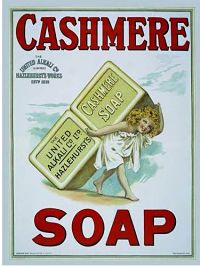 Before the advent of giant hoardings and huge printed posters, roadside advertising was much more restrained. In fact there is a song about the demise of corner shops which includes one verse:
Before the advent of giant hoardings and huge printed posters, roadside advertising was much more restrained. In fact there is a song about the demise of corner shops which includes one verse:On the walls enamel signs,
names of old to see.
Yorkshire Relish, thick or thin,
and Mazawattee tea.
Hudson´s soap, Robin starch,
bags of Reckitt´s Blue,
Sylvan Flakes and Oxydol,
and Nugget boot polish too.
The technique of porcelain enamelling on cast iron was developed in Central Europe in the early 1800s. An enamel sign is a sign made using vitreous enamel, and these were commonly used for advertising and street signage from1880 to 1950. Benjamin Baugh created the world's first purpose-built factory established by the Patent Enamel Co Ltd at Selly Oak, Birmingham, UK in 1889 for making such signs. Several other major firms sprung up in the following decades and thereafter the signs proliferated. They were used to advertise goods and services of every description right through until the 1960's, when posters and television advertising sounded their death knell.

The normal sites for signs were shops and similar retail or service premises such as garages. The proprietors would be paid a small fee to display and maintain them. They were often designed for specific places, such as beneath shop windows (long and thin signs) or at the sides of doorways (tall and narrow signs). Side walls and end gables were also popular. Some shops were natural sites for appropriate  signs, particularly newsagents, grocery stores, confectionary shops and tobacconists. Another common site was the railway station, and even in the early years of the 1900s, some market research techniques were used to identify the ideal position for maximum impact.
signs, particularly newsagents, grocery stores, confectionary shops and tobacconists. Another common site was the railway station, and even in the early years of the 1900s, some market research techniques were used to identify the ideal position for maximum impact.
 signs, particularly newsagents, grocery stores, confectionary shops and tobacconists. Another common site was the railway station, and even in the early years of the 1900s, some market research techniques were used to identify the ideal position for maximum impact.
signs, particularly newsagents, grocery stores, confectionary shops and tobacconists. Another common site was the railway station, and even in the early years of the 1900s, some market research techniques were used to identify the ideal position for maximum impact.Some of the earliest signs were for Sunlight Soap and Cadbury´s Cocoa or Chocolate, but other manufacturers soon joined in and the product range grew rapidly. Virtually anything that could be bought at a shop was suitable, groceries of every description, sweets, household cleaners, drinks and tobacco, shoes, furniture, medicines, pet food, the list is endless.
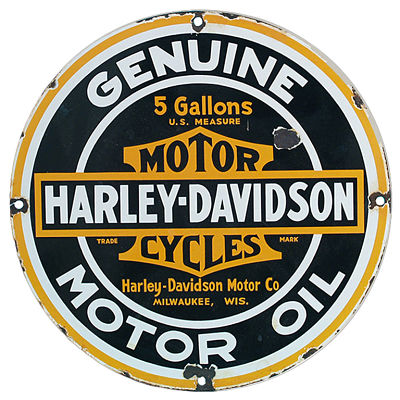
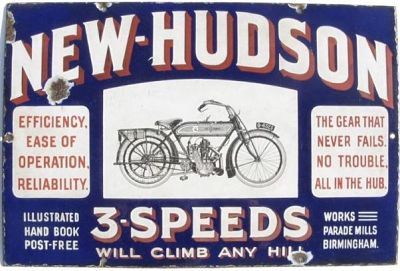
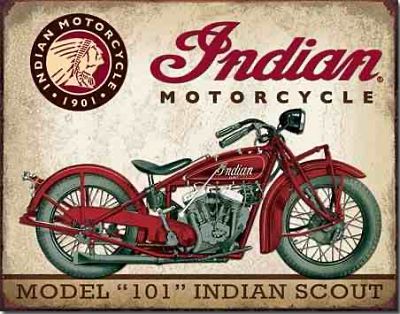
Other products include sewing machines, bicycles, motorbikes, prams, agricultural products, paints, fountain pens and ink, radios and gramophones, even tennis racquets. Services include car servicing and related fuel, oil and tyres, opticians, insurance, house removals, railway and shipping, travel and tourism. In fact, not much human activity was missed by the sign maker.

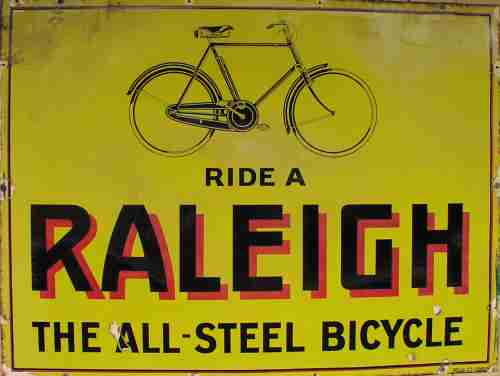
The majority of these signs are rectangular in shape although sizes vary enormously. The wording is often quite short and simple, with bright colours used 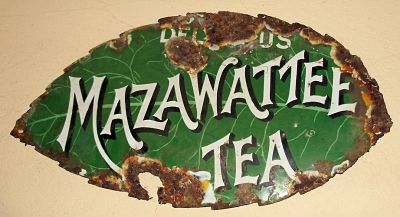 to attract attention. Longer texts are not uncommon but some of the most striking signs incorporate pictorial images and these are particularly desirable. Non rectangular signs are less common, although some firms used circular or diamond shaped signs and a few were cut out to special shapes, good examples including a man riding a Raleigh bicycle, a jar of Bovril and a tea leaf advertising Mazawattee Tea.
to attract attention. Longer texts are not uncommon but some of the most striking signs incorporate pictorial images and these are particularly desirable. Non rectangular signs are less common, although some firms used circular or diamond shaped signs and a few were cut out to special shapes, good examples including a man riding a Raleigh bicycle, a jar of Bovril and a tea leaf advertising Mazawattee Tea.
 to attract attention. Longer texts are not uncommon but some of the most striking signs incorporate pictorial images and these are particularly desirable. Non rectangular signs are less common, although some firms used circular or diamond shaped signs and a few were cut out to special shapes, good examples including a man riding a Raleigh bicycle, a jar of Bovril and a tea leaf advertising Mazawattee Tea.
to attract attention. Longer texts are not uncommon but some of the most striking signs incorporate pictorial images and these are particularly desirable. Non rectangular signs are less common, although some firms used circular or diamond shaped signs and a few were cut out to special shapes, good examples including a man riding a Raleigh bicycle, a jar of Bovril and a tea leaf advertising Mazawattee Tea.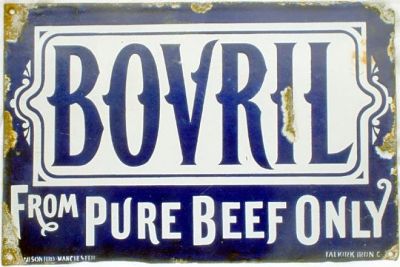 Double-sided signs were used for signs which would hang outside appropriate premises. The AA sign for example, would be from a garage or hotel, and other relatively common signs can be found for Pratt´s petrol, Rocklight paraffin and similar products. Some would have a specially designed bracket, sometimes in wrought iron, whereas others would simply have one edge of the surface bent back to form a flange which could be screwed directly to a wall. Double-sided signs were also quite commonly used for hotels, inns or public houses.
Double-sided signs were used for signs which would hang outside appropriate premises. The AA sign for example, would be from a garage or hotel, and other relatively common signs can be found for Pratt´s petrol, Rocklight paraffin and similar products. Some would have a specially designed bracket, sometimes in wrought iron, whereas others would simply have one edge of the surface bent back to form a flange which could be screwed directly to a wall. Double-sided signs were also quite commonly used for hotels, inns or public houses.There are also a range of novelty signs, several of which incorporate thermometers. Other 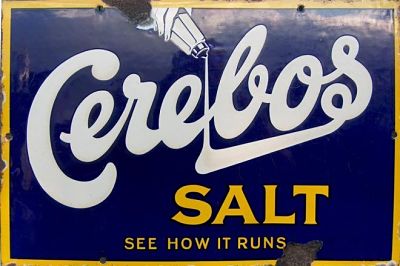 thermometer signs were used for Nut Brown Tobacco, Stephens Inks, Izal disinfectant, and even Brooklax, a chocolate laxative. An excellent variant was used by Gillette razor blades with the addition of a small barometer. Hudson´s Soap was advertised on quite a range of signs, amongst which are some fitted with a clock face and moveable hands. These could be set to show times when the bakery came in, when cyclists should light up in the evening, or when the shop was due to open or close, none of which have much to do with the soap!
thermometer signs were used for Nut Brown Tobacco, Stephens Inks, Izal disinfectant, and even Brooklax, a chocolate laxative. An excellent variant was used by Gillette razor blades with the addition of a small barometer. Hudson´s Soap was advertised on quite a range of signs, amongst which are some fitted with a clock face and moveable hands. These could be set to show times when the bakery came in, when cyclists should light up in the evening, or when the shop was due to open or close, none of which have much to do with the soap!
 thermometer signs were used for Nut Brown Tobacco, Stephens Inks, Izal disinfectant, and even Brooklax, a chocolate laxative. An excellent variant was used by Gillette razor blades with the addition of a small barometer. Hudson´s Soap was advertised on quite a range of signs, amongst which are some fitted with a clock face and moveable hands. These could be set to show times when the bakery came in, when cyclists should light up in the evening, or when the shop was due to open or close, none of which have much to do with the soap!
thermometer signs were used for Nut Brown Tobacco, Stephens Inks, Izal disinfectant, and even Brooklax, a chocolate laxative. An excellent variant was used by Gillette razor blades with the addition of a small barometer. Hudson´s Soap was advertised on quite a range of signs, amongst which are some fitted with a clock face and moveable hands. These could be set to show times when the bakery came in, when cyclists should light up in the evening, or when the shop was due to open or close, none of which have much to do with the soap!Hudson´s Soap also used a novel ploy to attract attention, with coded letters incorporated within their signs. They issued a small cardboard guide titled 'À Railway Puzzle Explained' which listed the codes, all of which are slogans such as 'Makes Washing Easy', or 'Improves Public Health'! The idea was clearly an early version of I-Spy designed to help while away on long train journeys and subliminally advertise the soap at the same time.
One other interesting points to note is that a number of signs bear the maker´s name, usually in small lettering in a bottom corner. Typical examples include Wymon & Sons of London, Chromo of Wolverhampton, Hanor Signs of Mitcham, and the Patent Enamel Co Ltd mentioned earlier. There are many others and this could provide a fruitful field of study for the more academically-minded collector.
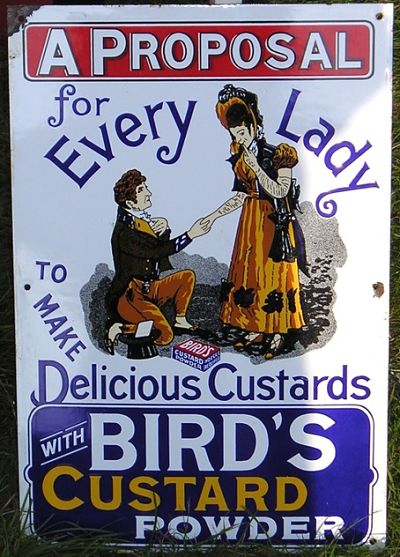 Today such signs are very collectable. Although not plentiful, they regularly turn up in auction sales, particularly with collectors' items. There are collectors of signs themselves, but there is also a good market for the specialist – a biscuit tin collector, for example, might like a Huntly & Palmer 'John Ginger' sign as a centrepiece for the collection; a collector of fountain pens would be attracted to a Waverly or Swan pens sign; any real ale enthusiast would be spoiled for choice.
Today such signs are very collectable. Although not plentiful, they regularly turn up in auction sales, particularly with collectors' items. There are collectors of signs themselves, but there is also a good market for the specialist – a biscuit tin collector, for example, might like a Huntly & Palmer 'John Ginger' sign as a centrepiece for the collection; a collector of fountain pens would be attracted to a Waverly or Swan pens sign; any real ale enthusiast would be spoiled for choice.Some signs have become particularly famous including the Fry's Chocolate sign depicting five boys in various stages of anticipation for their reward. Fry's also issued a range of comic advertising postcards by Tom Browne and two of these were also issued as enamel signs. Unfortunately you might need a small mortgage to acquire them.
As to value, the range is vast. A common small sign with simple lettering only may fetch around £20 or £30 whereas a large pictorial sign would be in the hundreds or thousands of pounds. As with all other collectables, condition is paramount. Being metal, signs are inevitability liable to rust, although the enamel surfaces are surprisingly robust and signs have been dug up from gardens or old tips in remarkably good condition. Some rusting around edges or mounting holes is quite acceptable, but when areas of rust impinge on significant parts of the design, value is adversely affected. As with all collectables, look for items that you like and are the best you can afford. Then you will get years of happy ownership.
Sadly, relatively few signs remain in situ although the odd survivor can sometimes be found.hopefully to remain for posterity. Examples are often on display in museums, but there is no doubt that they are best seen in original surroundings. Stations or preserved railway lines can be a rich source for in situ signs.
